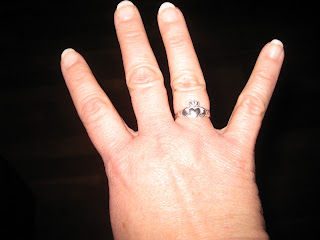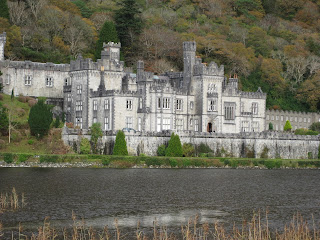The first things we did after Elaine’s arrival was talk, eat lunch and talk. And then we talked some more. After Elaine unpacked, we ventured out into the Latin Quarter. It was a lovely late afternoon. We first stopped at a jewelry store at the base of Shop Street in the Latin Quarter. We had a marvelous conversation with the woman working behind the counter. We learned that her family owns the store and she makes many of the rings that they sell. I planned to buy a Claddagh ring before I left Galway and that afternoon seemed like the right time. Plus, the price was right! Some Claddagh rings seem “bulky” to me, but she had one that was the size I wanted. I told her I would be having more visitors and I would be sure to bring them to her store. She said to tell whoever is working that I am a “regular” so I can get a discount. Score!
 |
| My new ring |
The jeweler (I really wish I had asked her name!) recommended some stores in Galway where we can be sure to find authentic Irish goods. She also recommended a tour to Connemara and Cong. Elaine and I took that tour yesterday. The beauty of the land and the stories of suffering endured by people in the Connemara region struck us both.
When we bought our tickets for the Connemara and Cong tour on Friday afternoon, the man in the tourist information office wrote “10:45” on the ticket to indicate the time we were supposed to meet our coach at the coach station. After a leisurely morning, Elaine and I arrived at the coach station well before 10:45 only to be told our tour bus had left at 10:00. We learned there was another tour at 11:30 but a different company runs that tour, so we would have to buy more tickets. Elaine and I set out to the Tourist Information office to collect a refund for our tickets. When we arrived at the office, the man who made the mistake, Fergal, was waiting for us. We didn’t have to explain what happened because he had received a call that alerted him to our situation. He offered to take us in his car to catch up to the coach we had missed. We agreed. He also offered to give us a walking tour of Galway early this week for our trouble. I am impressed by his efforts to make up for what is, really, a simple mistake. These are smart moves, of course, because they impact whether or not I would use or recommend this tour company again.
We met the rest of the tour at the first stop, the town of Cong. Cong was the setting for the movie, The Quiet Man, starring John Wayne and Maureen O’Hara. While we didn’t have as much time as the other tourists, we did get to see the ruins of an Abbey and a cemetery.
 |
| Elaine in the ruins of Cong Abbey |
All late-morning and afternoon we drove through breathtaking scenery. We saw mountains with countless coursing little and big streams. We saw sheep and goats and even some “bachelor sheep farmers” walking in the country. Our driver/tour guide, Michael, explained that most families left their farms to the eldest son. The other children moved away to other towns in Ireland or immigrated. According to Michael, some of these eldest sons have difficulty finding women who would agree to marry them and live on a rural farm, sometimes with in-house parents-in-law as part of the package.
We saw a male goat with one front and one back foot joined by a rope. Michael told us the reason the owner does this is because goats are remarkably agile (“they can walk on the head of a pin”) and if they are not tied in this manner, they will jump over the fence and run off.
We drove by many peat bogs and were told fascinating stories about how they were used to preserve food. Occasionally while cutting bog to use for fuel, the Irish find what is referred to as “bog butter.” Bog butter refers to the remains of food buried by people hundreds of years ago. Apparently a bog is a good people-preservative, too. I’m not going to go into detail, but extremely well preserved “bog bodies” have been discovered that date back over two thousand years.
I was sad to learn that it costs more money to shear a sheep than the wool is worth. Michael told us most of the sheep we saw were going to be sold for food. I had taken such comfort in thinking of the sheep as generating a renewable product--wool.
 |
| Elaine in Connemara |
 |
| Taken from inside bus, so some reflection on the window |
 |
| From inside the bus, again |
On our journey we also saw the ruins of what are now referred to as “famine houses.” A unique feature of a famine house is that its windows are bricked in. Michael explained to us that English landlords decided to add a tax per window that their tenants were required to pay. Unable to pay these taxes, the Irish bricked up their windows. This led the British to claim that the Irish “stole the living daylight” from them. According to Michael, this is the origin of that phrase.
 |
| Famine House Ruins through a bus window |
While we heard many sad stories on our tour, this next one brought me to tears. The setting is the great potato famine. While driving through a lovely area yesterday, Michael told us that during the great famine, 400 starving Irish walked miles to their landlord’s house. They had not eaten in three weeks. When the famine-ravaged Irish arrived at the landlord’s house, they found him hosting a large party. He turned the tenants away. Desperate, they began to walk back to their homes. That night turned cold and all 400 people died. News of the Irish famine spread to the Choctaw Indians of North America. Sixteen years before the famine, the Choctaw had endured the 500 miles Trail of Tears during which they faced starvation and disease; over half of the Choctaw perished. President Jackson had given each Choctaw one dollar. They collected what money they had left, $711, and sent it to help alleviate the suffering of the starving Irish people.
Our longest stop of the tour was at Kylemore Abbey and Victorian Walled Garden. The history of Kylemore Abbey is both fascinating and tragic. As newlyweds, Mitchell and Margaret Henry visited the Connemara region during their honeymoon. Margaret fell in love with the beauty of the place and Mitchell purchased the hunting estate in the mountains where they stayed and built a castle for him and his wife. The two lived a charmed life for many years. When one of their children became ill, they took him to Egypt to speed his recovery. While in Egypt, Margaret contracted dysentery and died within sixteen days. She was only 45. Heartbroken, Mitchell built a chapel to her memory on the grounds as well as a mausoleum. Mitchell found it too sad to stay at the castle after one of his daughters died in an equestrian accident, so he moved back to England. Most recently Kylemore was home to an order of Benedictine nuns who ran a school on the grounds. The school closed recently.
 |
| Kylemore Abbey |
 |
| Inside the walled garden |
 |
| The grounds of Kylemore Abbey |
 |
| The grounds of Kylemore Abbey |
 |
| The chapel |
After such sad stories, I’ll end on a lighter note. We drove through a little town called Recess. One resident of recess commissioned a statue of Connemara (son of the sea) and the plaque underneath says it was built “for no apparent reason.” We couldn’t see it, but there is also a plaque nearby that says something like, “In 1887 nothing of importance happened here.”
I have shared many sad stories that I heard on the tour of Connemara, but our driver told many jokes and funny stories, too. While I carry those sad stories in my heart, my overall impression of the day is more of beauty and resilience than sadness and tragedy.
 |
| Toward the end of our bus ride we were treated to the sight of a complete rainbow |


Rachel,
ReplyDeleteMy father in law went to visit a cousin in Roscommon and was deeply moved by the beauty of the place He remarked to the cousin that the site was gorgeous. The cousin responded "it is that now, but you can't eat the view."
Touugh the beauty is more constant than the tragedy, I cannot but believe that the latter has burned more deeply into the psyche of this people.
Ilove your stuff. Keep it coming.
J